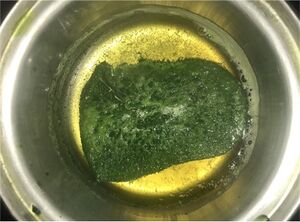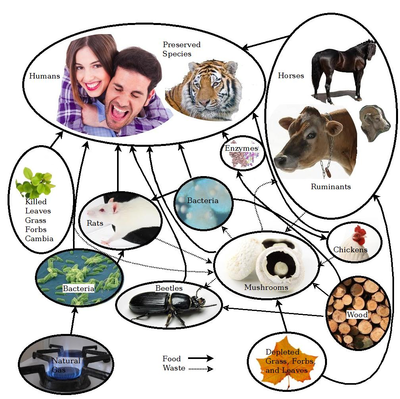
Background: Potential resilient foods which help reduce hunger are converting the ~998 million tons of agricultural residue generated each year into human edible food. Although it is possible to extract Leaf Protein Concentrate (LPC) from agricultural residues, it is not widely practiced because both toxicity and yields of the protein concentrates have not been widely investigated in the most common agricultural residues.
Methods: To fill this knowledge gap, this study uses high-resolution mass spectrometry and an open-source toolchain for non-targeted screening of toxins of nine agricultural plant residues in October 2021; it included seven agricultural residues: corn/maize, wheat, barley, alfalfa, yellow pea, sunflower, canola/rapeseed, and two weeds/agricultural residues of kochia, and round leaf mallow.
Results: The average yield ranged from about 7 to 14.5% for the nine LPCs investigated. According to the results, yellow pea, round leaf mallow, and canola are recommended for further investigation and scaling as they appear to be fit for human consumption based on the lack of dangerous toxins found in the analysis performed in this study.
Conclusion: All the compounds identified in these samples have either been approved by international regulatory boards for safe consumption or are known to be present in common beverages. The other agricultural residues require additional quantification of the toxins identified as it will determine the actual risk for human consumption. Overall, the potential for LPC to provide more needed calories from existing agricultural practices is extremely promising, but substantial amount of future work is needed to screen LPCs in all the agricultural residues depending on harvesting, handling, and storage conditions.
Source[edit | edit source]
- Source code: https://osf.io/h5vse/
- MZmine 2 https://mzmine.github.io/
- MFAssignR https://github.com/skschum/MFAssignR
- ToxAssign https://osf.io/nh76z/
See also[edit | edit source]

- Feeding Everyone No Matter What - The full book main page
- David Denkenberger and Joshua Pearce, Feeding Everyone No Matter What: Managing Food Security After Global Catastrophe , 1st Edition, Academic Press, 2015
- Free Preview: Google books
- Cover on Academia
- Facebook page
- Alternative Foods as a Solution to Global Food Supply Catastrophes
- Resilience to global food supply catastrophes
- Feeding Everyone if the Sun is Obscured and Industry is Disabled
- Cost-Effectiveness of Interventions for Alternate Food to Address Agricultural Catastrophes Globally
- Feeding Everyone: Solving the Food Crisis in Event of Global Catastrophes that Kill Crops or Obscure the Sun
- Food without sun: Price and life-saving potential
- Cost-effectiveness of interventions for alternate food in the United States to address agricultural catastrophes
- Micronutrient Availability in Alternative Foods During Agricultural Catastrophes
- Preliminary Automated Determination of Edibility of Alternative Foods: Non-Targeted Screening for Toxins in Red Maple Leaf Concentrate
- Open Source Software Toolchain for Automated Non-Targeted Screening for Toxins in Alternative Foods
- Scaling of greenhouse crop production in low sunlight scenarios
- Potential of microbial protein from hydrogen for preventing mass starvation in catastrophic scenarios
- U.S. Potential of Sustainable Backyard Distributed Animal and Plant Protein Production During & After Pandemics
- Global distribution of forest classes and leaf biomass for use as alternative foods to minimize malnutrition
- Long-term cost-effectiveness of interventions for loss of electricity/industry compared to artificial general intelligence safety
- Long term cost-effectiveness of resilient foods for global catastrophes compared to artificial general intelligence safety
- Rapid repurposing of pulp and paper mills, biorefineries, and breweries for lignocellulosic sugar production in global food catastrophes
- Nutrition in Abrupt Sunlight Reduction Scenarios: Envisioning Feasible Balanced Diets on Resilient Foods
- Methane Single Cell Protein: securing protein supply during global food catastrophes
- Killing two birds with one stone: chemical and biological upcycling of polyethylene terephthalate plastics into food
- How Easy is it to Feed Everyone? Economic Alternatives to Eliminate Human Nutrition Deficits
- Quantifying Alternative Food Potential of Agricultural Residue in Rural Communities of Sub-Saharan Africa
- Yield and Toxin Analysis of Leaf Protein Concentrate from Common North American Coniferous Trees
- Toxic Analysis of Leaf Protein Concentrate Regarding Common Agricultural Residues
- Towards Sustainable Protein Sources: The Thermal and Rheological Properties of Alternative Proteins
Additional Information[edit source]
- ALLFED
- Dave Denkenberger Publications
- OSE Wiki "Synfood" (i.e. protein and other dietary components from microbial organisms fed on gas or other hydrocarbons)
Davos IDRC Conference[edit source]
- Papers
- MOST completed projects and publications
- Famine relief
- Farming
- Food
- Food and agriculture
- Food crops
- Food processing
- Food production
- Food safety
- Food security
- Food storage
- Resilient foods
- SDG02 Zero hunger
- SDG12 Responsible consumption and production
- Open source software
- FAST Completed
- Sustainable development
- Public health
- Resilience
- Agriculture





